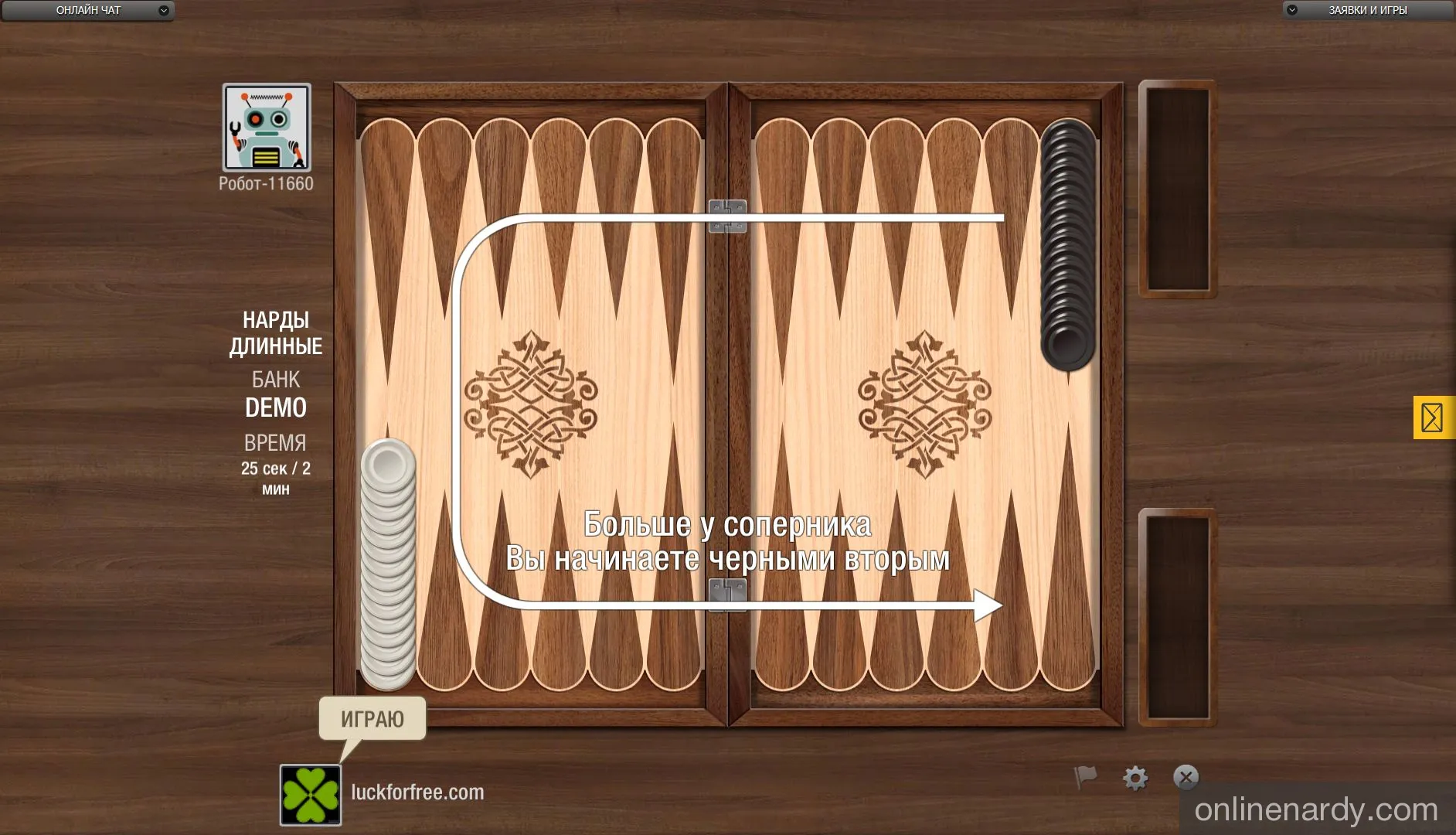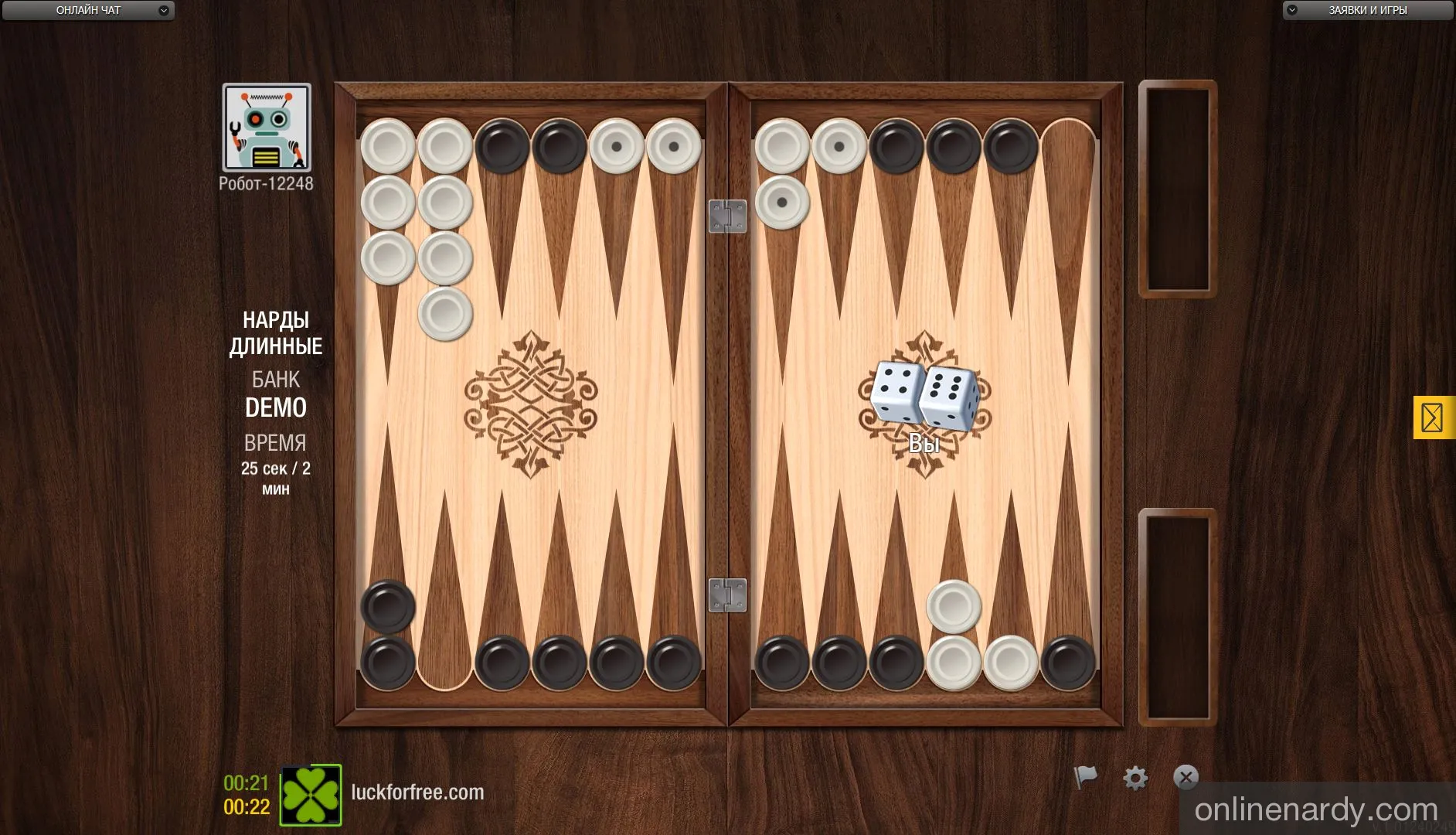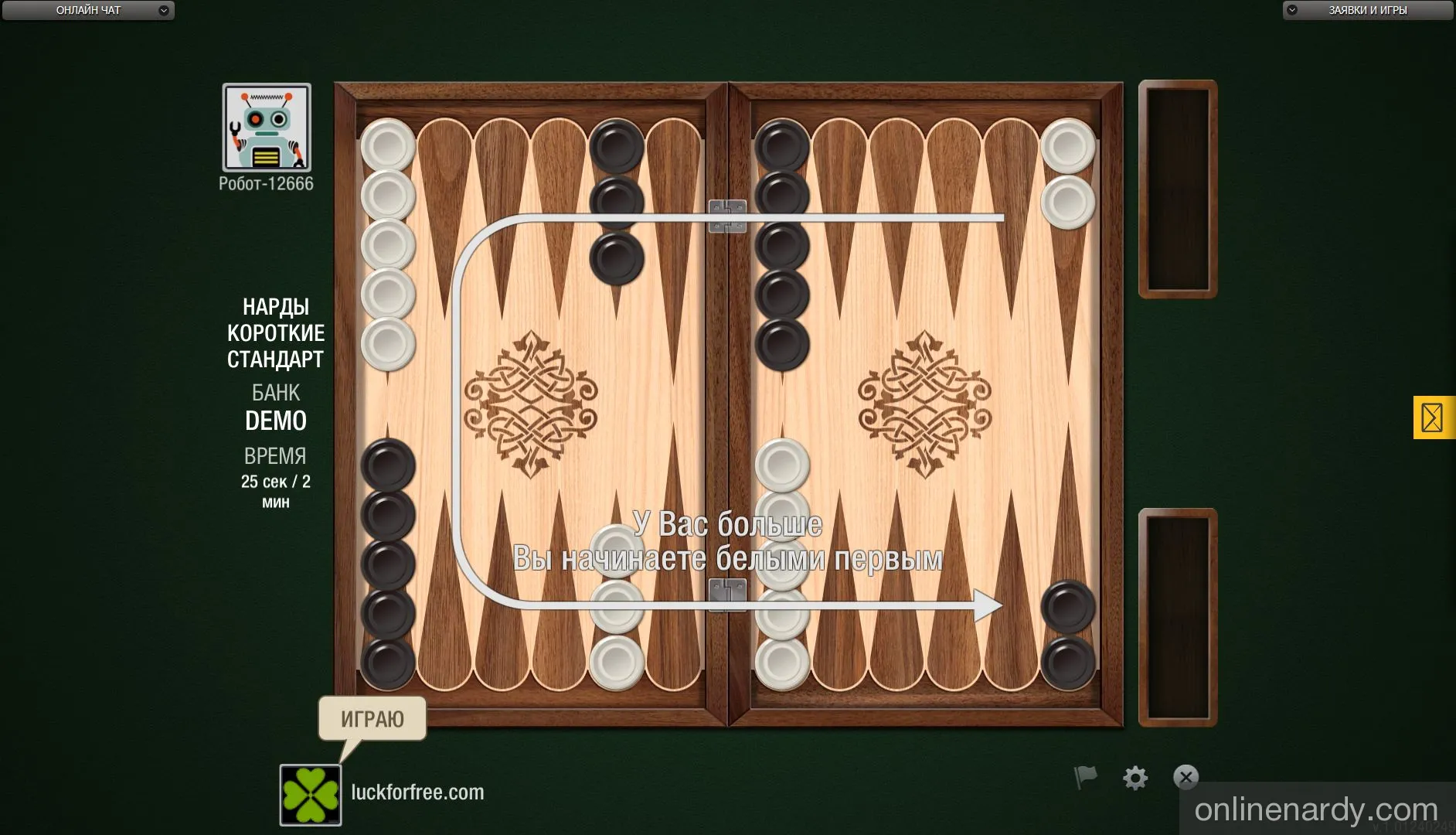- Online Backgammon
- /
- Backgammon rules
Rules of Backgammon
The benefits of playing backgammon are hard to overstate. Regular matches improve memory and mathematical abilities, teach concentration, and develop spatial imagination. The game promotes the development of strategic and logical thinking.
Rules of Backgammon for Beginners
Players will need a rectangular field marked in a certain way and 30 checkers: 15 white ones for one opponent and 15 black ones for the other. Also required are classic dice (called "dice") - cubes with dots on the faces, from one to six.
The field is divided into 24 points, forming four zones:
- home;
- opponent's home;
- outer board;
- opponent's outer board.

The order of play is determined by drawing lots, in the online version, this happens automatically. The participant with the higher number of points on the dice goes first. They receive the white checkers. Subsequent moves are made alternately. In the classic version (long variety), checkers move in a circular motion counterclockwise. They need to make almost a full circle around the board, i.e., come to the opposite side relative to the starting position.
Backgammon for Beginners - Features
To make a move, a participant rolls two dice simultaneously. In the virtual game, this action is performed by the computer. Then they move the checkers according to the number rolled on the dice. For example, if numbers 3 and 6 are rolled, one checker moves 3 points, and the other moves 6 points. During the first move, usually only one checker moves by the number of points equal to the sum of the scores on both dice. For example, if numbers 3 and 6 are rolled, the player moves a checker by 9 points (3+6). In case the player rolls doubles (2*2, 5*5, 6*6) during the starting move, they are allowed to use two checkers. In subsequent moves, a participant can move one checker or make two moves with different checkers: one is removed from the head, and the other is advanced forward. It is also allowed to move two checkers that are already engaged in the game.
If it's possible to move according to the values of both checkers, backgammon rules prohibit moving according to only one value out of the two rolled. The player moves one checker only if there is no possibility to move the second one. Even when it is disadvantageous, the partner must make a move for the higher number rolled on the dice.
Any number of checkers can gather on one point, but if there is already an opponent's checker there, it is forbidden to place your checkers there. If doubles are rolled, according to backgammon rules and rules for beginners, you can make four consecutive moves.
Backgammon Rules - General Provisions
After all checkers are gathered in the home, they need to be borne off the board. According to backgammon rules, checkers can be borne off the board if the rolled number matches the point where the checker stands. If a certain point already has no checkers when a particular number is rolled, the move is made from the higher point. If all checkers are on lower values than the numbers rolled, the checker is borne off from the lower point by seniority. For example: if 4:6 is rolled, and checkers are only on points 1 and 2, the one from point 2 is borne off first, then from point 1. The player who bears off all their checkers from the board first wins.
There are several varieties of the game, but the most popular are long and short.
Rules of Long Backgammon
At the beginning of the match, players receive 15 checkers of contrasting colors and place them along the left edge of the game board. Drawing lots determines who will move first. Whoever gets the higher number of points on the dice plays with the white color and starts the match.
Participants need to move around the board in a circle in the direction opposite to the movement of the clock hands, and then bring the checkers home (the last, lower-right quarter of the board). Then, the first player needs to bear off all their checkers from the board.

Long Backgammon Setup
Checkers are placed in the twelfth and twenty-fourth points respectively. This position is called the "head." Next, the player rolls the dice and makes a move according to the values rolled. Opponents move with their colored checkers, taking one checker from the head each. The number of points rolled on the dice corresponds to the number of points the checkers can move on the board. The player who first brings all their checkers home and bears them off the board wins.
Rules in Long Backgammon Are Accessible to Everyone
During one move from the head, only one checker can be removed. The exceptions are doubles 6:6, 4:4, 3:3 on the first roll. If such doubles are rolled, it is allowed to move with two checkers taken from the head because it is impossible to move with just one checker. Players move according to the values rolled on the dice. For example, if the dice show numbers 2 and 5, the player moves one checker by 2 and the other by 5 points, or one by the sum of the rolled numbers (2+5). If doubles are rolled, the number of moves is doubled.
The number of checkers on one point is not limited. Placing your checkers where an opponent's checker is already present is prohibited. During the match, long backgammon rules allow for building blocks - placing more than six checkers in a row. This is possible if at least one of the opponent's checkers is in front of such a block.
After rolling the two dice, the participant moves. For example, if the dice show numbers 1 and 6, the player moves one checker by 1 and the other by 6 points, or the single checker by the sum of the rolled numbers (1+6). If doubles are rolled, the number of moves is doubled.
If a player cannot make a move, they skip their turn. If a full move is possible, even when it is not advantageous for the player, they must move. For example, if the rolled numbers are 5:6, and it is more beneficial for the player to move one checker by 5, nevertheless, they must move 5:6 with another checker if such an opportunity exists. In situations where only one move is possible, the player must use the higher number rolled on the dice.
At the end of the match, it is required to bear off the checkers from the board. The participant uses the rolled values as they see fit: either bear off the checkers or move them within the home. For example, if 4 and 6 are rolled, checkers are removed from the fourth and sixth triangles respectively. If suitable checkers are not available, they can be removed from the triangle with the lower value, provided that there are no checkers left on the triangle with the higher number.
The game cannot end in a draw. After the first participant bears off all their checkers from the board, their opponent is declared the loser. However, in the game settings, there is an option to play with the right of the last move for black, as whites started the game. This evens the chances of winning.
Mars and Oin
The game also has "Mars" and "Oin" settings, which serve as game-ending options:
- Choosing the "Mars" option, players remove an additional "Mars" bet at the start of the match. If the "Mars" condition is met, the winner receives double the loser's bet, and the loser loses their entire bet. If the conditions are not met, both players' bets are returned.
- Choosing the "Oin" option, additional bets are not removed, and no additional payments are made.
Rules of Short Backgammon

Two players participate in the game. They will need:
- board;
- thirty checkers of two contrasting colors;
- dice (cubes).
The playing field is divided into territories, as in long backgammon. The strip between the home and the outer board is called the "bar."
In short backgammon, the following setup is provided by the rules: each partner has five checkers in the 6th triangle:
- two in the 24th,
- three in the 8th,
- five in the 13th.
Players need to make a full circuit around the board, return the checkers home, and bear them off the board.
Participants take turns rolling one die each: whoever gets more points starts the game. If an equal number of points is rolled, the players roll the dice again until different values appear. In the virtual version, the computer determines the order of moves. Both dice are then used. Checkers always move in a circular direction.
The values on the dice indicate how many points the checkers need to move. They are moved strictly in one direction: white checkers move counterclockwise, black checkers move clockwise. You can only move to a triangle where there are no two or more opponent's checkers.
For example, if numbers 3 and 4 are rolled, the player moves one checker by 3 points and the other by 4, or moves one by 7 immediately. In this case, this checker must have the ability to visually stop at 3 or 4. A double roll allows for four moves.
Rules of Short Backgammon for Beginners
Both values rolled on the dice must be used. If only one of them can be used, then the move is made accordingly. If each number can be played separately, the larger number must be used. A participant only gives up their turn if they cannot make a move.
In short backgammon, there is the concept of a "blot." This is a triangle where only one checker is located. When an opponent's checker enters such a point, it hits the opponent, and the hit checker moves to the bar. Therefore, you should try to place two or more checkers in one point to avoid being hit by the opponent. A hit checker needs to be "loaded" - returned to play. To do this, a number must be rolled on the dice that will move the checker to an unoccupied point occupied by the opponent.
After all 15 checkers have returned home, they need to be borne off the board. To do this, the dice are rolled again. Checkers on points corresponding to the rolled numbers are borne off the board. For example, if 2 points are rolled, a checker is removed from the second point. If the rolled number points to an empty point, a checker can be borne off from points with numbers less than the number of points rolled on the dice.
The winner is the one who first bears off all their checkers from the board.
Rules of Caucasian Backgammon
The rules of Caucasian backgammon are almost identical to the rules of short backgammon, with the only difference being a small but fundamental nuance.
A player is not allowed to hit an opponent's checker in their own home and then hide on their own checker. In other words, if you hit an opponent's checker, you cannot immediately place it on a point occupied by another one of your checkers during the same move. However, you can move it further to an empty point or remove another one of your checkers from the board and place it on the attacked point.